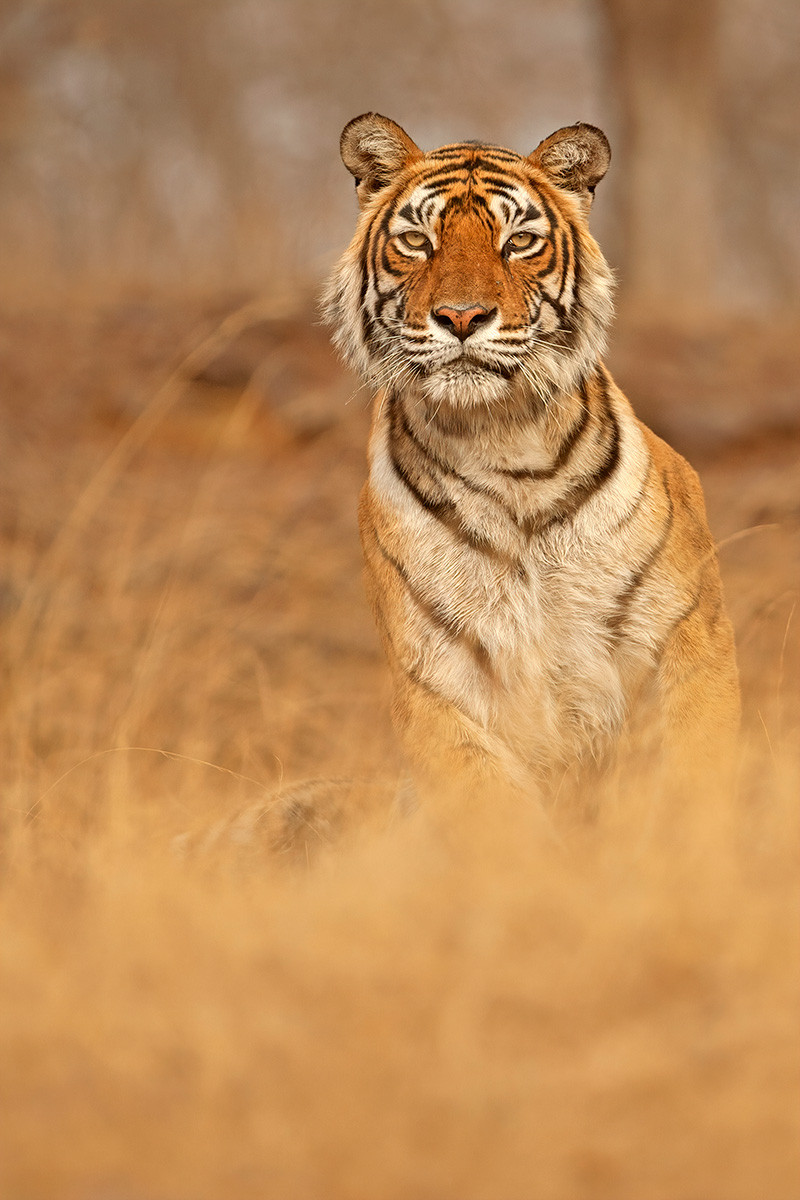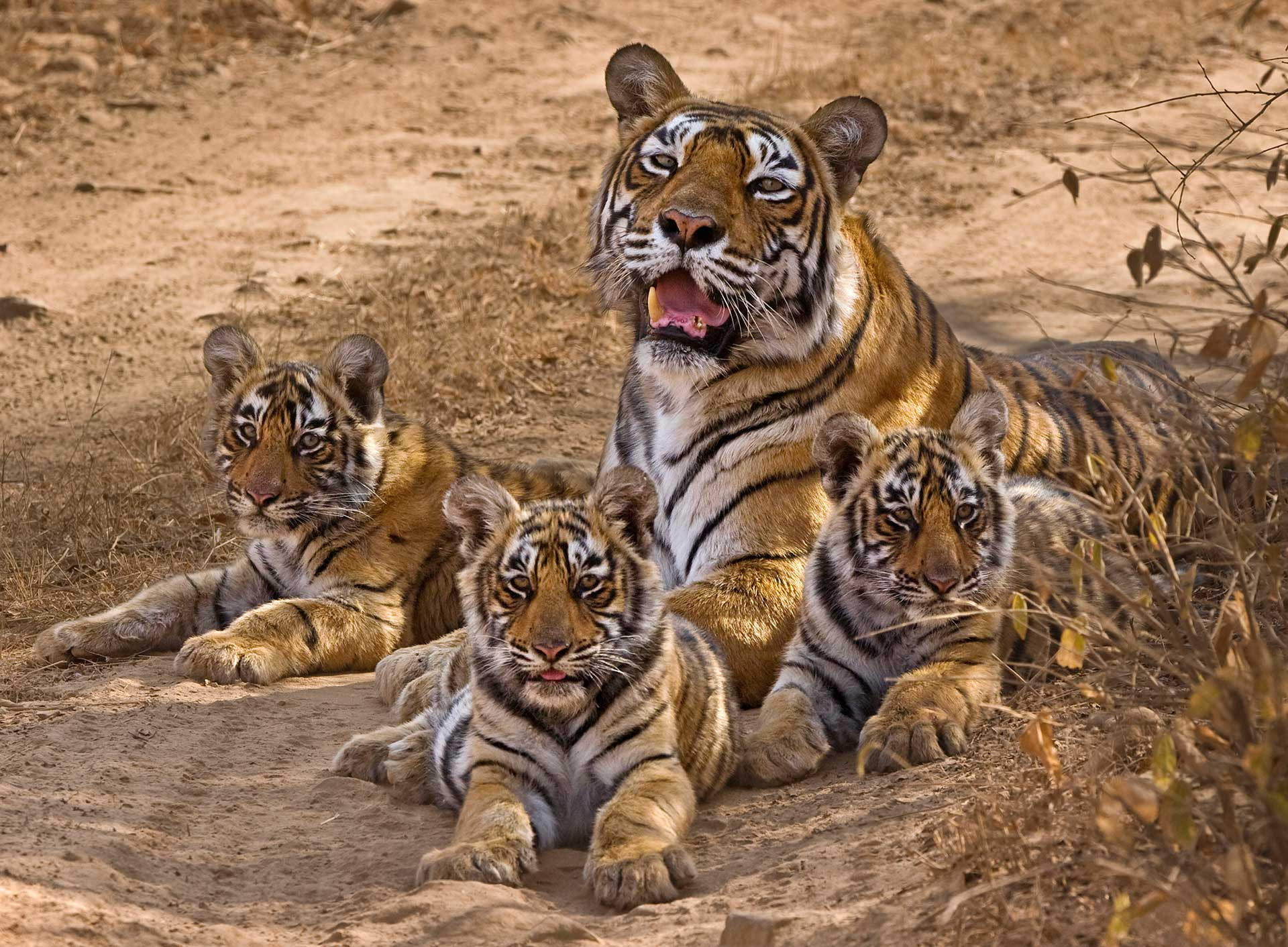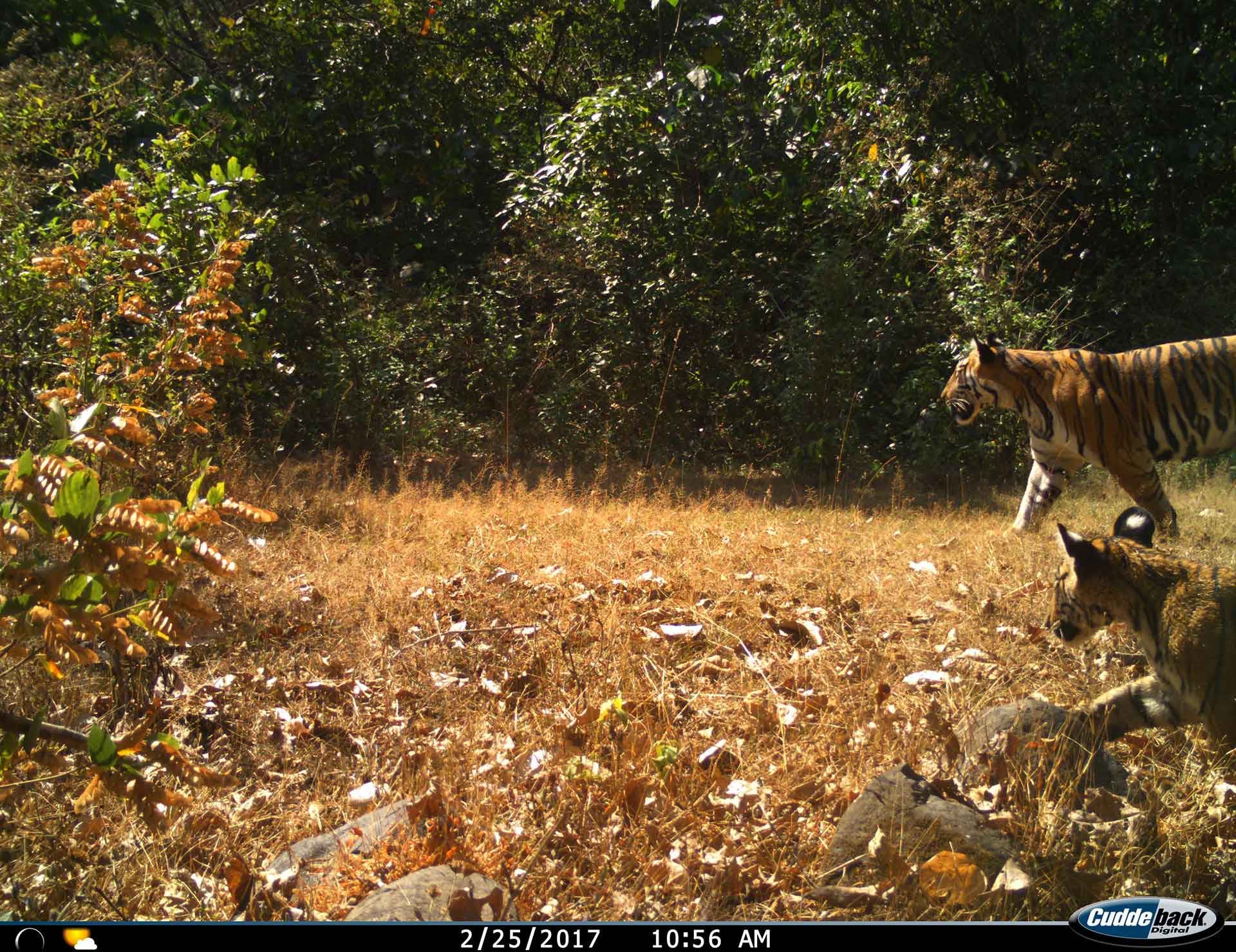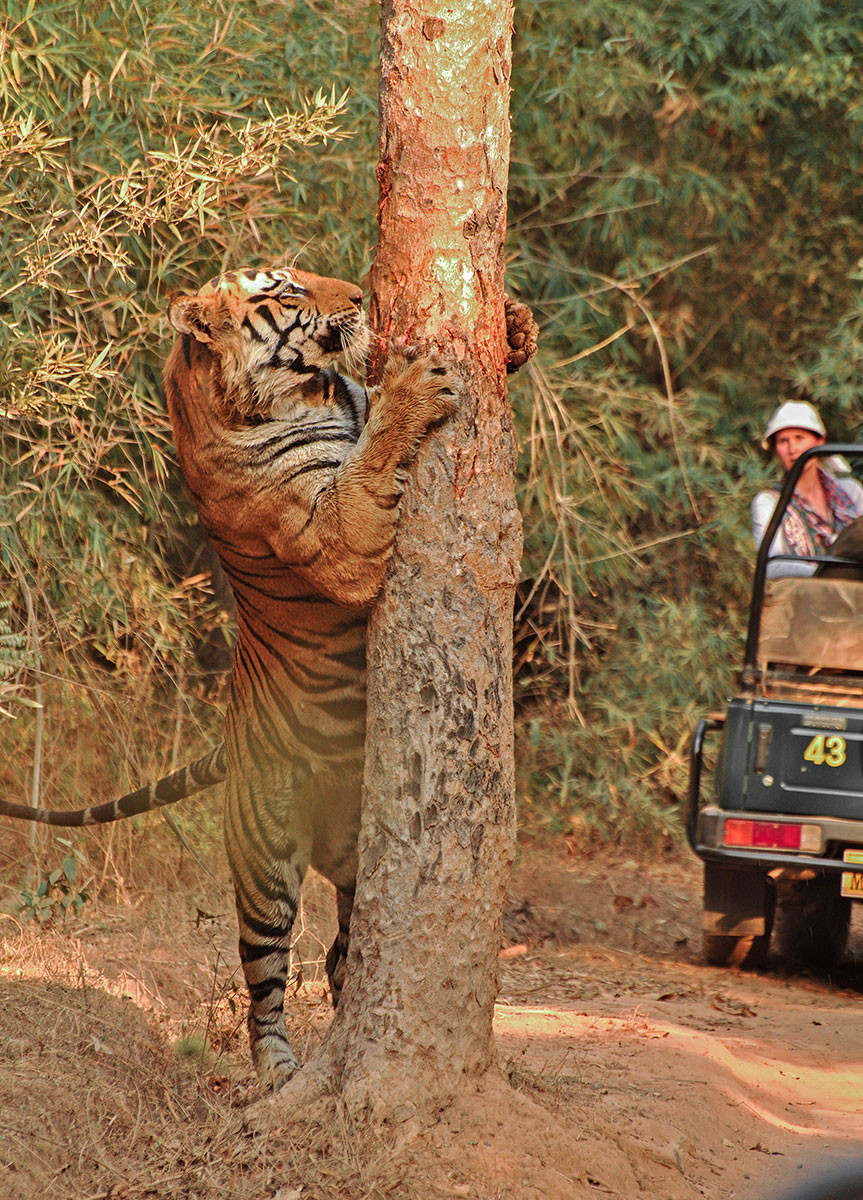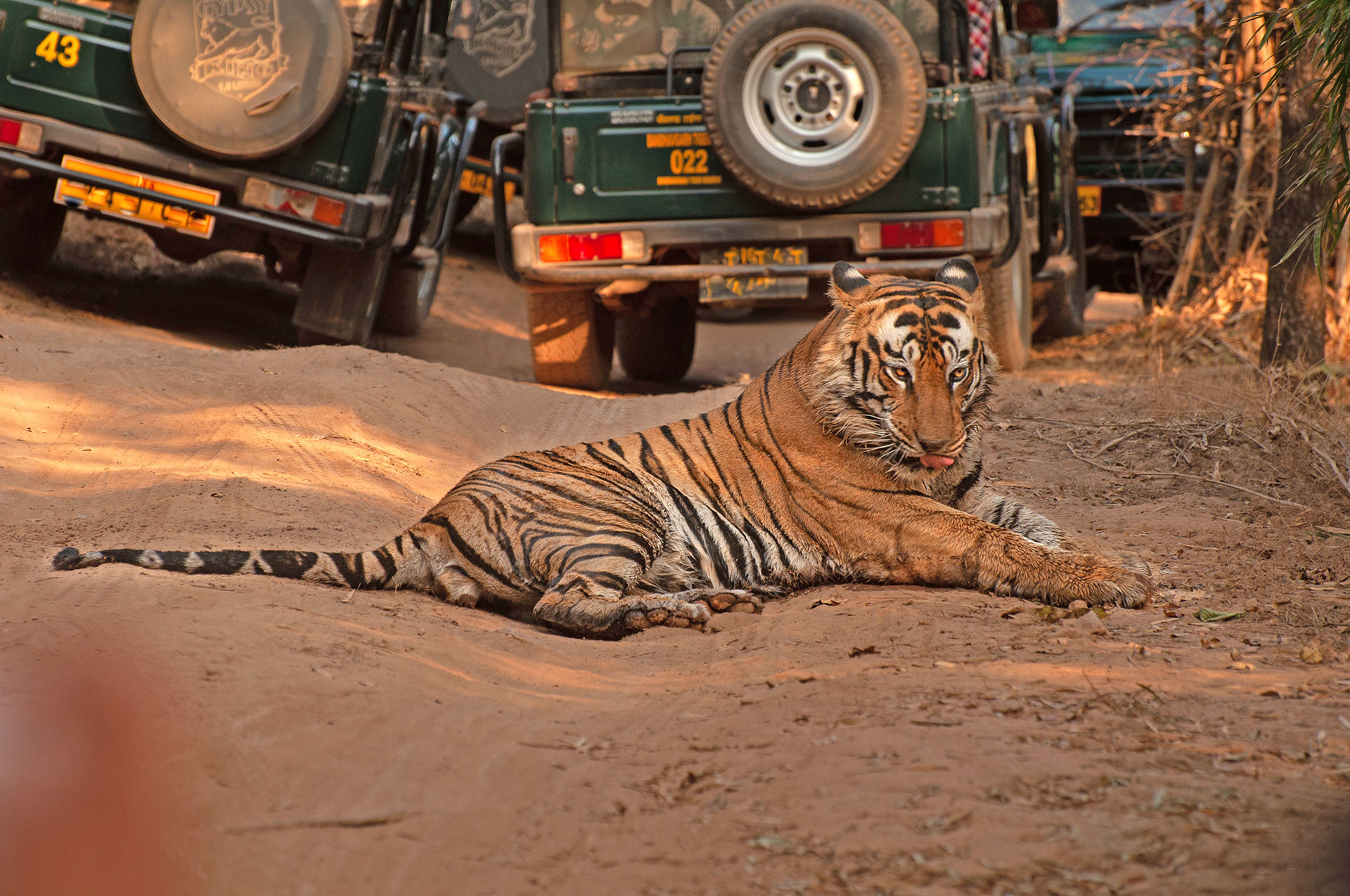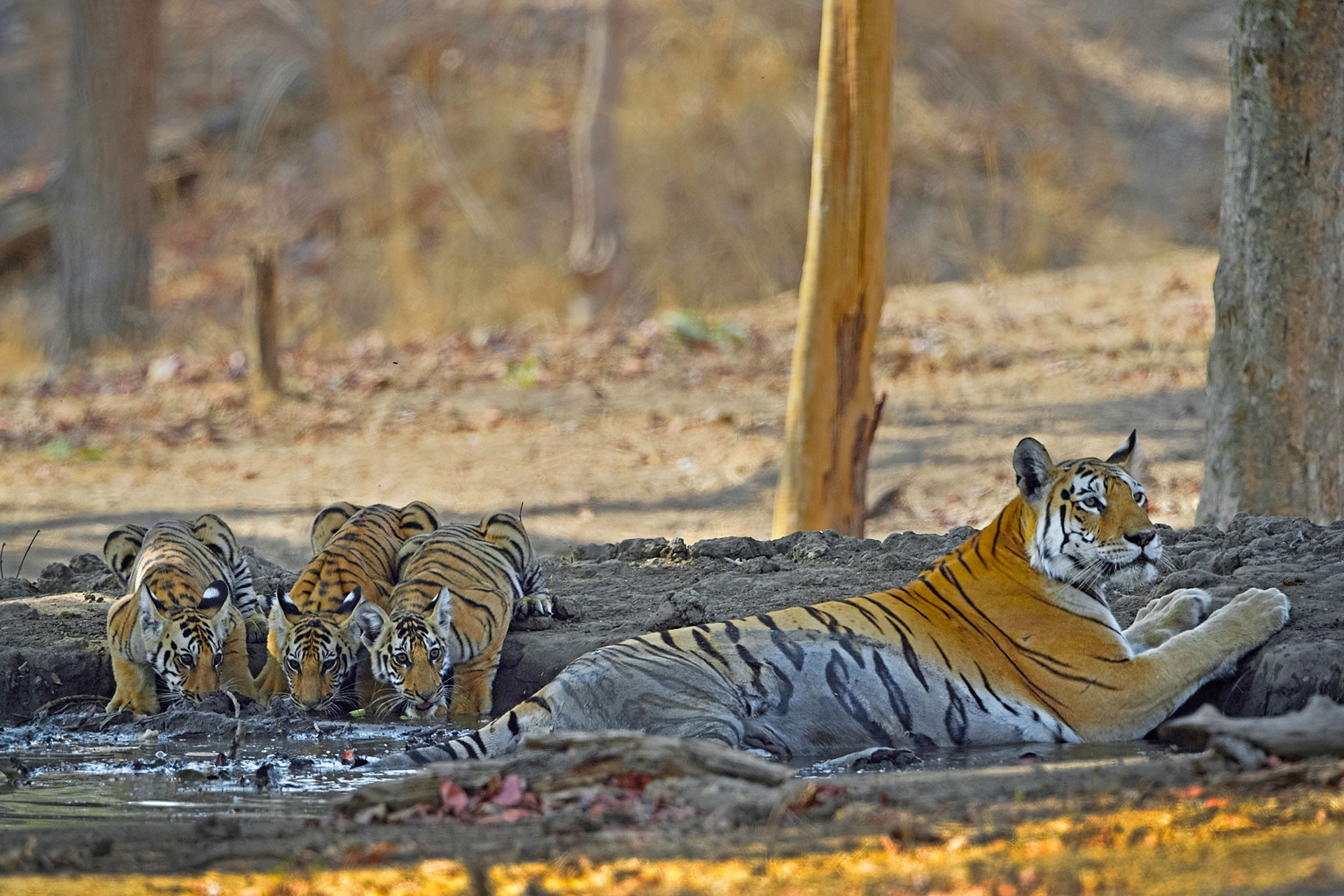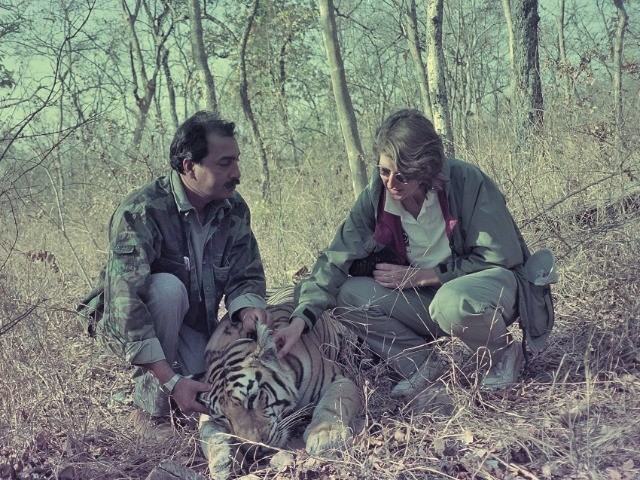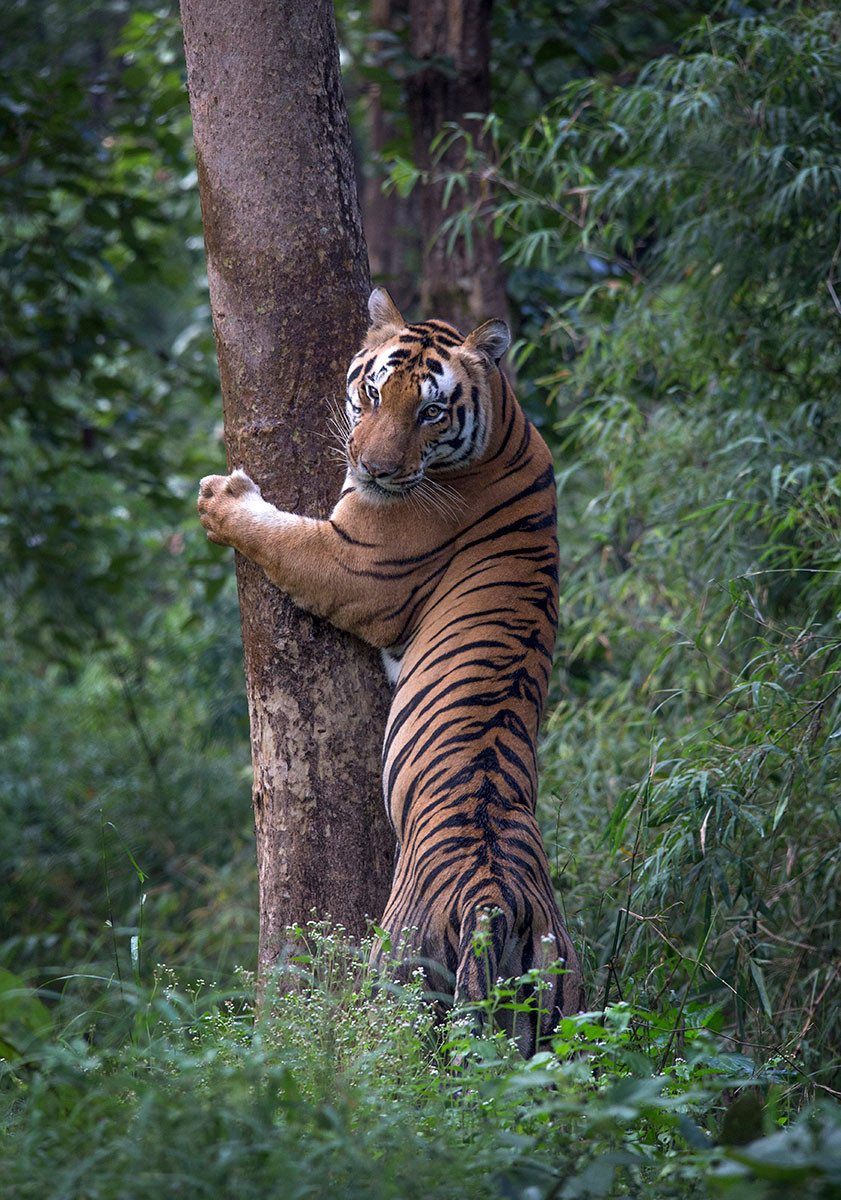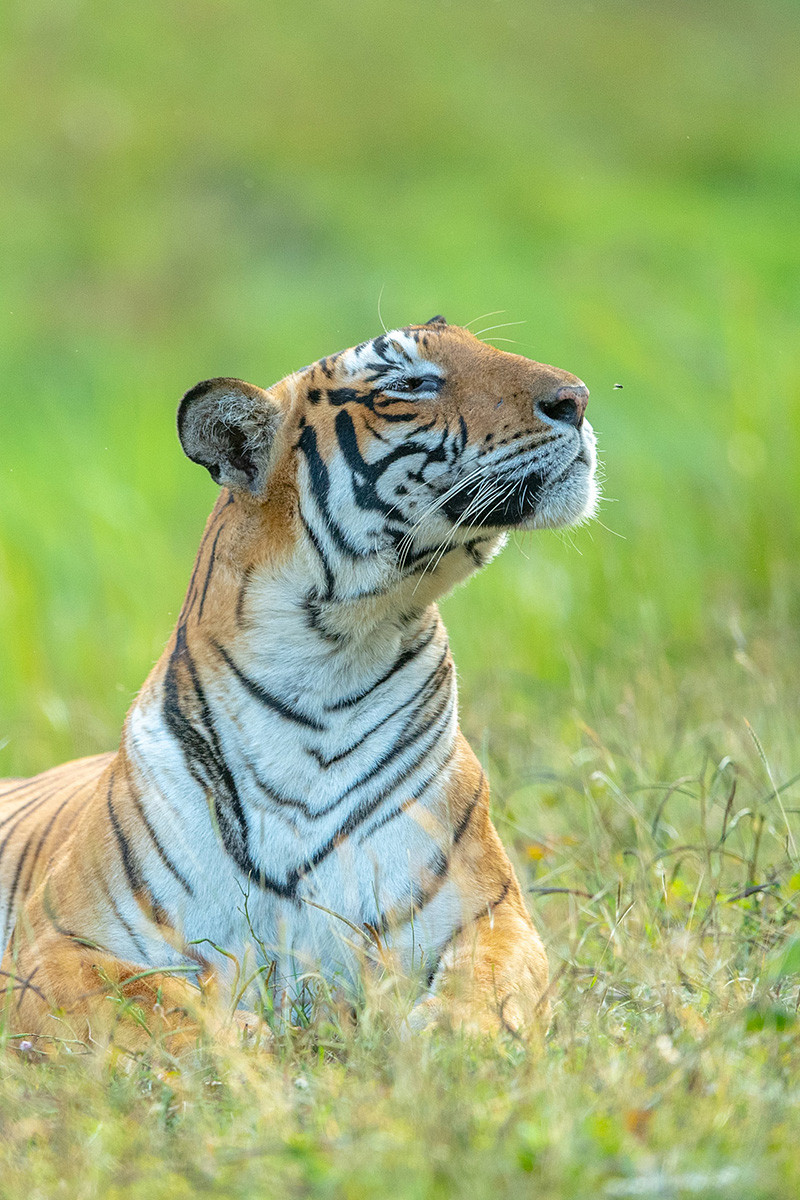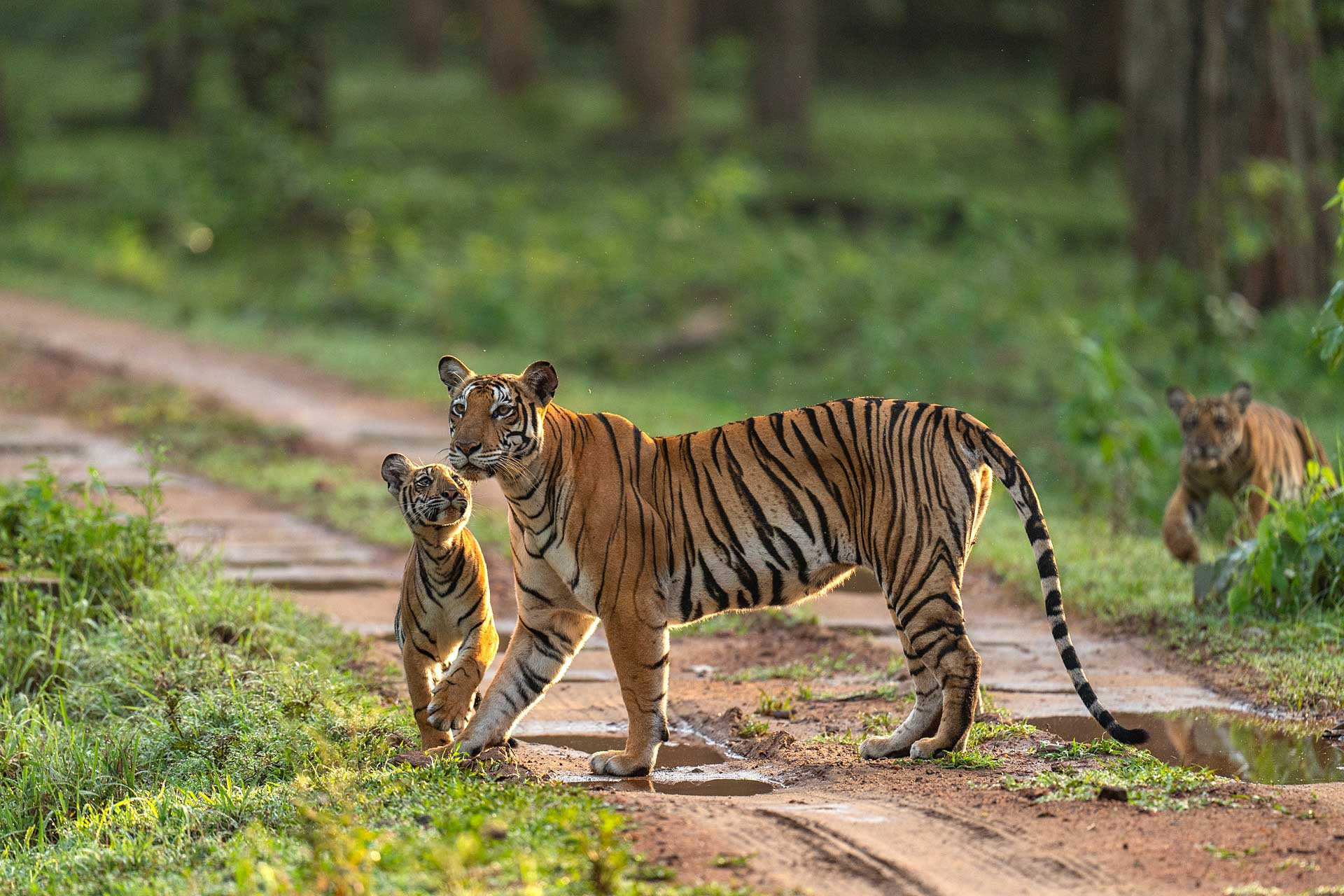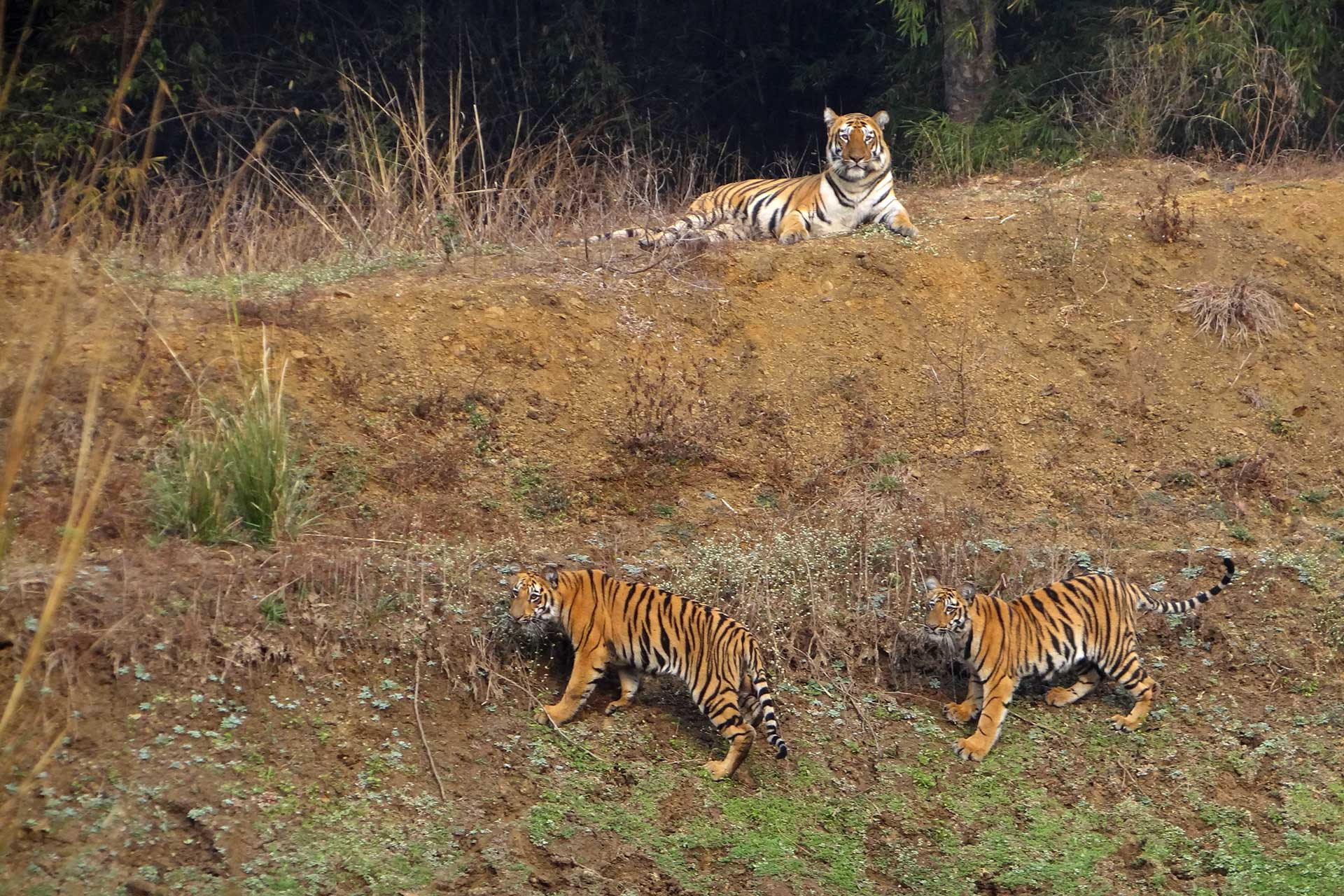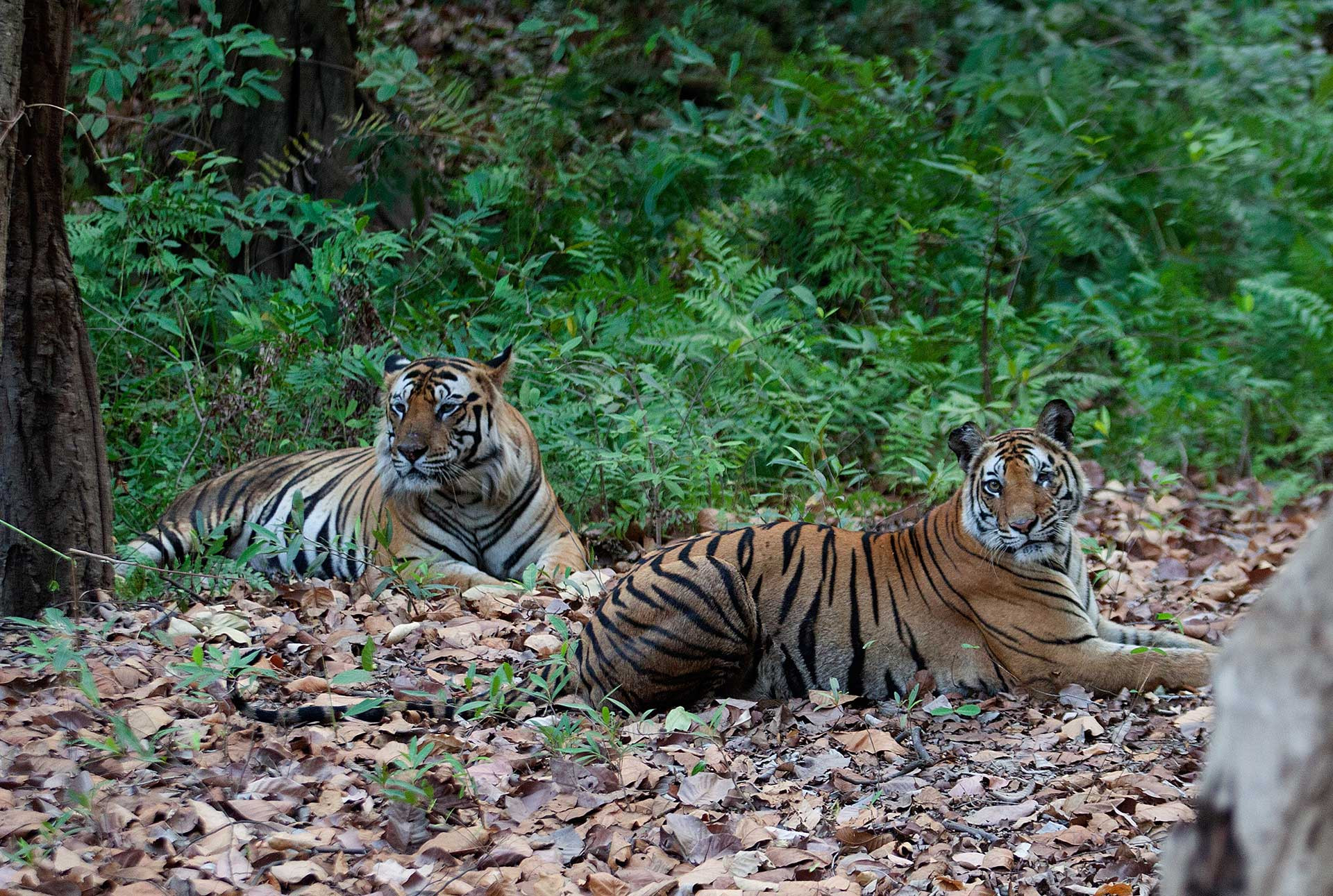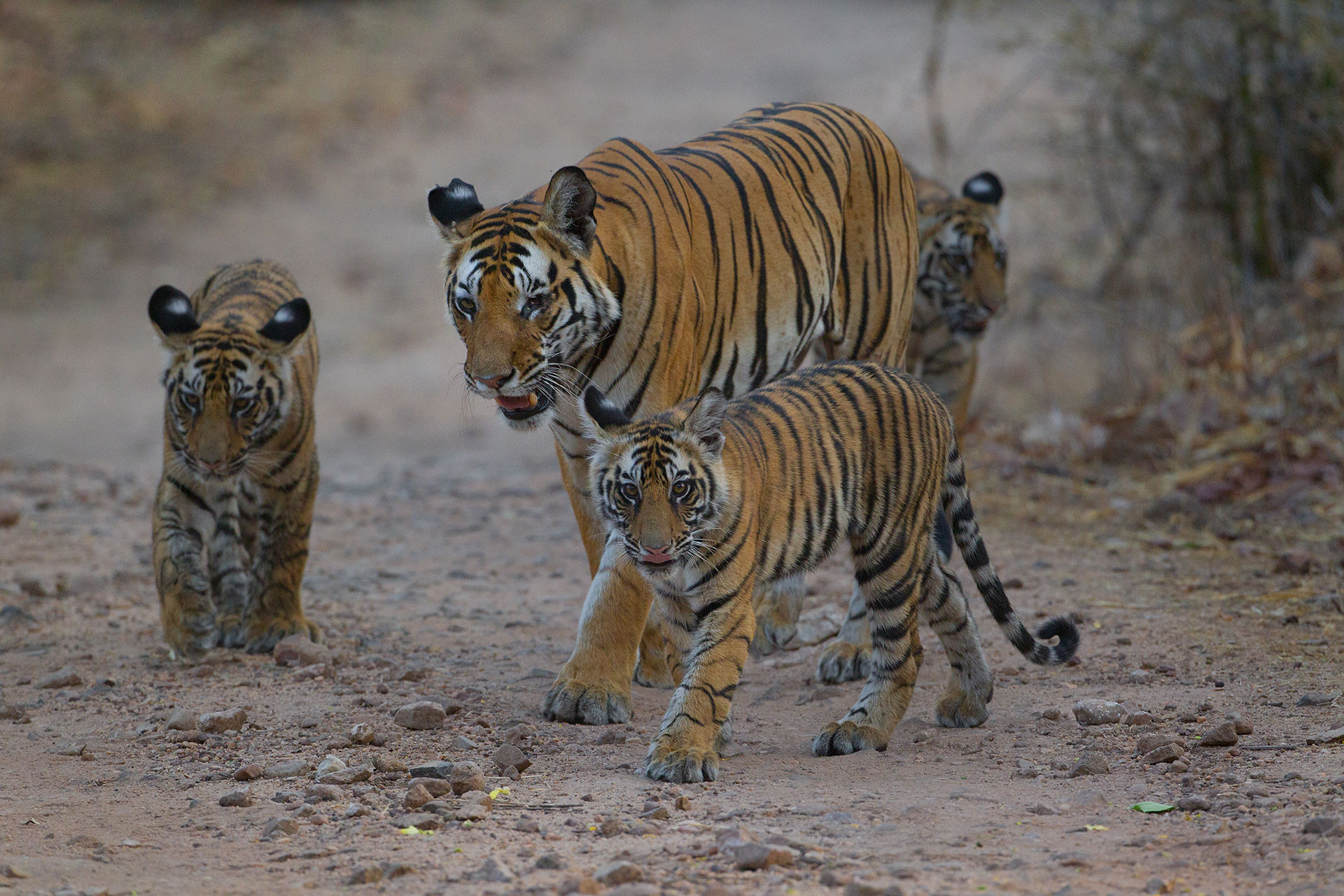As a wildlife enthusiast, there are certain moments that you will never forget. The first time you set foot into the wilderness, your first wildlife photograph or the time you witnessed a unique natural history moment. High up on this list is the first time you set your eyes on a tiger.
The stripes, the stealth and the captivating eyes—no matter how many times you see or photograph a tiger, it is impossible to subdue the awe that its presence draws. But there are tiger sightings and then there are TIGER SIGHTINGS! India’s national parks are home to several tigers that have marked their presence in their unique ways—Machali–The Tiger Queen of Ranthambore, Bamera–The Hulking Giant of Bandhavgarh, and Backwater Female–The Star of Kabini, to name a few. More recently, the death of the legendary 'super mum' tigress Collarwali saw an outpouring of grief in the wildlife fraternity, a testament to her popularity.
What makes these tigers unique? Why are some more memorable than others? This International Tiger Day, we pose these questions to wildlife photographers, filmmakers, biologists, conservationists and naturalists, asking them to share stories about some of their favourite tigers. These stories reveal an underlying passion for the wilderness and for the striped cats. But beyond that, they reveal how mesmerising these big cats are. Hop on, as this is going to be a truly wild safari.
T-16 aka Machali
In the monsoon of 1997, a tigress called Machali, named after a mark on her left cheek that looked like the outline of a fish, gave birth to a litter of three female cubs. One of them, the dominant one, T-16 as she was officially numbered, later became known as the famous Machali. My wife Poonam and I first saw Machali and her family on March 12, 1998. I remember the date very well because it was the day before the festival of Holi, and it was the first time my wife saw tigers in the wild. A few months later, we relocated permanently to Ranthambore. By early 1999, I had started working on a BBC documentary on the tigers of Ranthambore, particularly focussing on this family of cats.
For the next 15 years, I spent a few months every year following or trying to follow Machali. We documented her life for different projects, from her coming of age to her successfully raising four litters till her old age. Machali died in 2016 at a ripe old age of 19 years, the longest that any tigress has ever lived in the wild. This long life was probably because, 2014 onwards, she was given live bait periodically (almost once a month) as it became difficult for her to hunt successfully. Right now, there is another tigress in Ranthambore nearing Machali’s age, and she lives without any help, but that is for another story.
There is a curious story about her name. When BBC started their first documentary called The Tiger’s Fortress, T-16 was referred to as ‘The Lady of the Lakes’ while her mother was called Machali. The project got over by the end of 1999, and the film did very well. The name Machali was a hit with the European and American audiences. In the summer of the year 2000, BBC came back for a sequel but by then the “original” Machali was no more. The Director–Cinematographer Colin Johnson, my dear friend, badly wanted to use the name Machali, so he decided to rename the daughter (who was till then known as The Lady of the Lakes). He was confident that not more than a dozen people would see the difference, and he was right.
Paarwali aka Paro
Every tiger reserve in India is synonymous with an iconic tiger. In recent times, when anyone refers to Corbett Tiger Reserve, they also mention the name Paro or Paarwali in the same breath. Paro was first seen sometime between 2013-14, when she was about three years old, trying to carve out her own territory. While her lineage is a subject of debate, the popular opinion is that she belongs to the last litter of a tigress known as Thandi Maa from Dhikala Chaur.
Paro made the area across the Ramganga river her domain and gradually extended it to both sides of the river, chasing away two older tigresses. A petite-looking tiger by Corbett standards, Paro was bold, confident and fierce when defending her territory. By 2015-16, she was a showstopper, never disappointing the eager tourists who came seeking a glimpse of a Terai tiger. She was every photographer's muse. Photographing a Terai tiger in the crystal clear waters of the Ramganga had been an elusive dream for all till Paro claimed the river as her own.
Paro had her first litter in 2016, but she was an inexperienced young mother and lost her three cubs to a leopard attack. The next litter was in 2017, of which one did not make it through the monsoons. The only surviving cub was a young boisterous male, the apple of her eye. Mother and son roamed the Terai together, and it was thought that, at last, Corbett would have its first bold male tiger. Alas, in the summer of 2018, the young cub, fondly called Nawab, was mauled by a tigress invading Paro's territory. The young one succumbed to his injuries, despite medical intervention by the Forest Department. Paro's last litter was in 2018, three bold and beautiful females, each embodying their mother in every aspect. The cubs successfully reached adulthood and carved out their own territories within Corbett. However, this came at the cost of Paro, as she was ousted from her domain. Paro was last seen in 2020, a frail remnant of her glory days. Her pug marks which were once easily recognised by the guides, drivers and regulars no longer imprinted on the white sands on the banks of the Ramganga. No one really knows what became of her. But her presence is still felt as she lives on through her offsprings.
TT2
The northern Sahyadris is a rugged and hilly landscape, not known for its tigers, but I’ve had an exciting time monitoring them here over the last decade. Interestingly, even in this ‘sink landscape’, there’s one tiger that I’ve closely followed for nine years, using camera traps, and she has survived against all odds! This is TT2’s story and how she brings me hope that we can restore a landscape to support a fair number of wild tigers along with other co-predators and wildlife.
TT2 was one among the three tigers that we (this includes my field associates and the forest department staff) first photographed in a forested valley of southern Maharashtra in 2014. Her initial camera trap images were slightly blurred, but we could still identify her as a different individual. The following year, we set out again to monitor her during the drier months. Armed with a camera trap of a better make, we descended from a boat and started walking towards where we had photographed her the year before. The reservoir water level had receded a lot that year, so we had to walk on the exposed sand banks before reaching the valley. I noticed an animal on the bank, and on getting closer, realised that it was an adult gaur killed by a tiger. Numerous tiger tracks littered the area. We quickly set up our infrared camera on a log of dead wood a few metres from the kill. A week later, we found TT2 with three cubs!
This was exciting to me, as TT2 (& TT1) was a breeding pair living outside a Protected Area* (at that time). We have been monitoring this valley almost every year since and in 2017, she was captured again with a new litter of three cubs! The sub-adults from the previous litter had mostly dispersed by then. The cubs from 2017 also dispersed the following year (two survived to become sub-adults), and one of those now resides in the Mhadei Sanctuary of Goa, photographed in 2022. TT2 still survives in the valley, and we recently captured her on camera. Visibly old but still doing well. I hope I can see her again after this monsoon, and knowing her, I think I will!
*These areas were declared as Conservation Reserves by the State Govt. Of Maharashtra in 2020-21.
Bamera
I first heard of a tiger named Bamera in the summer of 2010 while conducting a survey in the buffer villages of Bandhavgarh Tiger Reserve. At the time, he had gained notoriety for lifting cattle and had planted a certain degree of fear in the mind of the villagers. "Bahut bada hai sahab, itna bada tiger humne aaj tak nahi dekha! (He’s gigantic, madam. I’ve never seen a tiger this big to date!)" spluttered a villager, a resident of the same village that gave Bamera his name. Located in a beautiful region known as Panpatha, with a massive dam and an ever reaching green landscape, Bamera was as beautiful a tiger and as extravagant as his namesake village.
Very quickly, Bamera made an entry into Bandhavgarh as its dominant male, overthrowing his ageing father, B2. Slated to be the biggest tiger Bandhavgarh had seen for a few years, Bamera tickled everyone's imagination into becoming a stuff of legends among the drivers and guides of the park. "Arey, gaadi ke bonnet jitna bada hai (Hey, he’s as big as the bonnet of the jeep)," some claimed while others gestured with their hands an unrealistic proportion to specify his size and width. But all had one declaration in common- "Bilkul B2 jaisa hai, shant aur shareef (He’s exactly like B2, always calm and collected)." Dying to sight this ‘darling of the forest’, I finally saw him in the summer of 2012, during one of our Village Kids' Awareness Programmes. (The idea behind the programme was to take children from the buffer villages inside the forest via a safari, and help them experience the biodiversity and wilderness which they lived in such proximity to. This not only gave the children a chance to experience the forests, but also strengthened community participation in the protection of the landscape.)
During one of these trips with the village children, we entered the beautiful Tala zone of the reserve and as soon as we drove closer to the vast Chakradhara meadows, we came across an evidently uneasy herd of Sambar deer. Several hesitant honks and foot stampings later, we saw him, magnificent and a blazing ochre in the summer sun, ignoring the frenzied Chital and honking Sambar to finally settle down in a pool of water in the grassland. Drinking water at sporadic intervals, he looked around lazily and slowly drifted into a hot summer afternoon nap. As expected, other vehicles rushed in to see him, clamouring with each other to get a better look at him, when one of the drivers laughed and said "Yeh Bamera hai, aaram se dekho, itni jaldi uthne wala nahi hai! (This is Bamera, he isn't going to leave the spot so soon, you can watch him to your heart's content!)” and he was right. That summer, Bamera was quite the show-stopper for the kids, appearing almost everyday, only to be met with gasps and admiration. The children, in fact, went back to their homes after a rendezvous with the hulking beauty and regaled their families with stories of all they had seen and the highlight of their day, 'Bamera'!
The winning moment for me was when a small girl explained to her family about how they had been wrong in their perception of tigers being bloodthirsty and unforgiving. "Bagh bahut sundar hota hai aur ab hamara dost ban gaya hai, humein baghon ko bachana chahiye, baghana nahi (Tigers are beautiful and now they are also our friends. We should protect tigers, not get rid of them).” That year, and almost six years into the programme, till the end of 2018, many children were able to change the mindsets of their families in favour of forest protection, and by that, bringing down the rate of human-wildlife conflict by almost 80 per cent. I would like to believe that Bamera, in all his glory, brought together people and a change in mindsets.
T-15 aka Collarwali
Collarwali of Pench needs no introduction. She is believed to be the only tiger in the wild to have given birth to 29 cubs (in eight litters) in her lifetime, the first in 2008 and the last in 2019. A record 29! Born in the year 2005, I still remember her as a little cub brushing herself upon her mother. She became famous after the documentary Spy in the Jungle, which covered her journey from infancy to adulthood. Collarwali was well-built and dominant, and was the first one among her siblings to carve out her territory in the heart of Pench Tiger Reserve. Since then I have been fortunate to watch her grow, evolve and successfully raise litter after litter. She was the first tiger in Pench to get fitted with a radio collar, thus earning her the moniker ‘Collarwali’. A prolific breeder, she not only contributed heavily to the gene pool of Pench Tiger Reserve, but today, her offsprings thrive in other tiger reserves too, after relocation.
Fondly called ‘Mataram’ which translates to ‘beloved mother’, she breathed her last on January 15, 2022 due to complications of old age, and has been put to rest in the area where she reigned till her last.
I consider it my honour to have documented and photographed the life of Collarwali, spanning over 16 years. I can proudly say that I am the only person to have documented and photographed all eight litters of Collarwali. I have made a family tree of Collarwali with the help of all the data and photographs I have collected over the years. Whenever I remember Collarwali, I recollect my most memorable sighting of her with her five cubs sitting scattered on the rocks ashore the Pench river. Though she is no more today, her legacy lives on.
You may also like to read
Link 7 Male
I started my life as a naturalist in Satpura in 2011. In those days Satpura was known for alternative experiences like walking and canoeing and its overall biodiversity but not for its tigers. We barely saw tigers in my five years there. When I moved to Kanha in 2015, this was my first stint at a major tiger park. And just around the same time, a young male tiger arrived at the Mukki zone of the park. He was known as Link 7 Male, owing to his place of birth which was "Saath (seven) number road" in the Kanha zone. Mukki was a ‘male tiger battleground’ with three large males already roaming in the area. This young challenger surely had his work cut out if he hoped to keep a slice of Mukki for himself.
In my two years at Kanha, I saw him grow, not just in size but in his dominance. He spent the initial months playing smart, avoiding the larger males, disappearing for weeks together into the hills and then returning to the lowland battlegrounds. He was chased around and injured by the other males, but he always came back stronger. Towards the end of my two years in Kanha, he had emerged as the top tiger of the region ousting (possibly) two of the other males. Link 7 Male was the first bold tiger I had the pleasure of observing. He gave me, and everyone else in Kanha, some fantastic insights into the world of a central Indian male tiger. I moved to Ladakh after that and managed to see him a few times during my short visits to Kanha. Link 7 Male disappeared in 2019-20, for reasons unknown, while he was in the prime of his life. I've been to Kanha a few times after, I've seen other tigers and heard their stories from the guides, but the two years I spent with Link 7 Male have to be my best years with one of India's wild tigers.
Backwater Female aka Kismat
As someone who has been travelling to Nagarahole National Park in Karnataka for almost 20 years, I have noticed how sighting tigers has become easier over the years. Between 2006-2010, very few individual tigers were recognised by regular visitors, and amongst them was a beautiful tigress we referred to as the Backwater Female. Her territory extended towards Kakanakote and the backwaters of Kabini in Nagarahole, earning her the moniker. She was often seen courting the Mastigudi Male, a massive tiger that roamed in the same area. One of her cubs turned out to be bold like the mother, and was frequently sighted in the area, around 2016-17. Referred to as Kismat by some, she grew up to steal the hearts of visitors, including that of mine. When the mother passed away, the daughter inherited both her name and territory.
Most tigers in Southern India avoid being in the company of tourist vehicles, a glaring difference from the tigers found in parks like Ranthambore or Bandhavgarh, where they are totally at ease with tourist vehicles. Backwater Female was an exception in this regard and is probably one of the most frequently sighted tigers in Kabini and possibly the whole of southern India. She had her first litter in the late summer of 2018; the three little cubs were frequently sighted during the monsoon and winter months. Even today, some of these male cubs roam the area as young adults. After the first lockdown of the pandemic, I was probably the first photographer to sight Backwater Females' second litter. She had three cubs in the second litter as well. Off late, she has been sighted less frequently until earlier this week when she showed up with more tiny cubs. This time, four of them followed her onto the road as a couple of safari vehicles trailed them. Kabini's tiger sightings will only be on the rise in the coming years as these cubs grow up, hopefully as bold as their mother.
One evening, we were exiting the park very close to sunset, and ours was the last car. Backwater Female was standing by the undergrowth, watching us. As we waited patiently, she walked out and lay in the middle of the road, blocking our way. We were confused about whether to complain about the roadblock or celebrate her sighting. Within a couple of minutes, three tiny little cubs walked up and sat beside her. They were perhaps 5-6 months old. It was a remarkable evening! She's been out of action for a while now. But now that she has put on her first show, it's only a matter of time before sighting the Backwater Female along with her cubs becomes a regular affair for Kabini aficionados.
T-24 aka Sonam
When I joined Tadoba in 2020 as a wildlife biologist, I was overwhelmed by the mere thought of meeting all the famous tigresses of Tadoba—Maya, Tara and Kuwani, to name a few. Little did I know that I would be sharing territory with one of them! Yes, you read that right! I stay not more than one km from Telia and often hear roars at night, and on one occasion even saw the ‘Queen of Telia’ and her cubs inside the tourism complex! T-24, popularly known as Sonam, is the dominant tigress of the famous ‘Four Sisters of Telia’. She snatched the Telia Dam territory from her mother T-10 aka Madhuri, a decade ago. She gets her moniker from the ‘S’ mark on the right side of her neck.
In 2020, Sonam's young cubs were a major attraction! I kept hearing stories about her being a valiant mother, how she had killed leopards to protect her cubs. I placed a camera trap on the carcass of one of her leopard kills and was able to capture pictures of T-24 and her cubs for the first time. Once, our cameras even captured images of the cubs chasing a porcupine; thankfully all the cubs escaped the incident without any injuries. My rather virtual relationship with Sonam continued until one day on our way to check some camera trap units, we came across Sonam and her cubs by a waterhole. It was my birthday and my neighbour had decided to give me the best gift ever by putting a full stop to our distant relationship! As Sonam basked in the winter morning sun, the cubs played in the water, and when one over-enthusiastic started to approach our vehicle, she was quick to discipline and call the little one back with a growl. It was my first tiger sighting in Tadoba and will remain a special memory forever.
I call T-24 my ‘Lady Luck’. Ever since that day at the waterhole, I have spotted tigers on almost all my field days! I watched all three cubs grow up, and saw one of them rescued from a village. Not all tigers get to enjoy life in a pristine habitat like Telia, some get lost in human habitats and make the heartbreaking journey to life behind bars at a zoo after frequently straying into villages. This year, I saw Sonam and Bajarang together, prior to her giving birth to her latest litter of three cubs. I saw her fighting with her sister Lara to keep the territory she has built over a decade. Sonam still holds the crown of ‘Queen of Telia’, and I take a lot of inspiration from this stalwart of Tadoba.
Vijaya AKA Kankati
I still remember the first time I set my eyes on Vijaya in Bandhavgarh. Among all the striped kings and queens of the region, Vijaya stood out as the bold tigress that had set her sights high. Wildlife photographers would wait for hours to get just one glimpse of Vijaya, but she never made it easy for them. Legends like Charger, Seeta and B2 have walked the lands of Bandhavgarh, but none of them left a lasting impression like Vijaya.
Vijaya knew survival was a difficult game, so she chose to dominate the Chorbehra and Chakradhara region, right up until the Bandhavgarh Fort. This region hosted a strong prey base, abundant water sources and several apt hideouts. But Vijaya had one stiff competition, Lakshmi, a disabled tigress fiercely protective of her territory and cubs. In 2010, Lakshmi and Vijaya engaged in an epic battle that left Vijaya with a permanent mark—a lost eye. However, that did little to protect Lakshmi, whose half-eaten remains were found by the forest officials the next day! For Vijaya, though, the battle of dominance did not end there.
After the monsoon season of 2011, forest officials searched the park for Vijaya and were delighted to know that she was now a mother of three cubs. Her chosen mate was an equal match, the dominant male of Bandhavgarh, Shashi. But the tides were slowly changing in the landscape, and a new dominant male began making an appearance over the next few years. While Vijaya steadfastly protected her now sub-adults, even drawing out the new male in the process, her attempts were futile. Two of her cubs were found dead near the Bandhavgarh Fort area and one at another location, a few days later. But Vijaya being the fierce leader she was, refused to give in. In the summer of 2014, she was seen with her new litter of three cubs! Sadly, her story ended soon after. Forest officials found the decomposed body of a tiger, and a post-mortem revealed that it was Vijaya.
I owe my interest in storytelling to Vijaya. The grand tales of her battles echo in my ears every time I visit Bandhavgarh. It was the first time I had followed a tiger for so long, spending 200-odd-days documenting its life. While the book that I intended for Vijaya came to an abrupt end with her death, she is the inspiration behind A Decade with Tigers: Supremacy, Solitude, Stripes, my humble tribute to Vijaya's tenacious spirit.


